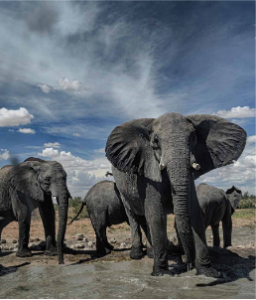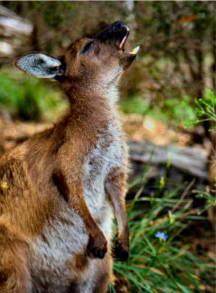Etosha National Park, an arid, salty-white landscape in northern Namibia, is home to the world’s largest elephants. Size is relative; the only true measure is to stand next to one. So here I am in Etosha, face to face with a full-grown bull elephant. How is it possible? How have I not been squashed?

PHOTO: © RICHARD NEWTON
The secret lies in the pane of elephant-proof glass between us. I am in the hide at Olifantsrus Camp; the elephant drinks from the waterhole immediately on the other side of the window. He appears to be aware of me, but thirst is his greater concern. He sucks huge quantities of water into his trunk, then hoses it into his mouth. I gaze up, awestruck.
My lifelong passion for wildlife has taken me all over the world, giving me many memorable encounters. Few have been as close as this. In any venture into the wilds, you need to adhere to two overriding priorities: Minimize disturbance to the animals and ensure your own safety. This remarkable hide gives you proximity without compromising those priorities.
Later, from the hide’s upper level, we look directly down on a lioness as she drinks. We can hear every lap of her tongue and can see her tawny hide shudder in response to the flies buzzing around her. Melodic birdsong provides the soundtrack as the sun sets and the light fades. Eventually the lioness pads off into the advancing dusk as another elephant herd cautiously makes its way toward the waterhole. The end of an unforgettable day.
We travel for many reasons. Whether on business or for leisure, experiencing different places and cultures is endlessly enriching. But traveling to watch wildlife adds an extra dimension. Nothing can be taken for granted. You can spend hours looking with no reward, or you can have a once-in-a- lifetime encounter. Nothing is guaranteed, and anything is possible.
In Alaska I once flew by floatplane to Kaflia Lake in Katmai National Park. We coasted to the shore, where I jumped from the floats onto the beach. The intention was to hike to a safe overlook close to a waterfall where we might see grizzly bears catching salmon. It was early September, the peak time for grizzlies fattening up on fish before their winter hibernation. My two companions were still on the floats when one of them pointed a finger along the beach. There, unmistakably, was a grizzly bear heading my way.
The golden rule in almost every encounter with a dangerous animal: Don’t run. Separated from my companions, too far from the plane to retreat, I had no option but to hold my ground. The bear reduced the distance and didn’t notice me at all until he was around 30 feet away. He suddenly stopped and sniffed the air, then made a detour around me. I didn’t breathe until his shaggy hulk began to recede.
Not every close encounter proves as dramatic as that. On Ecuador’s Galápagos Islands, a two-hour flight west of the South American mainland, the unique animals show little fear of humans. Time and again you find yourself checking your stride to avoid stepping on a lava lizard or a marine iguana or a seal pup. Once, while I was photographing a Galápagos hawk, a Galápagos mockingbird landed on my head and perched happily for a minute or two.
Wildlife viewing in the Galápagos Islands presents a form of culture shock. The usual rules that govern interactions between humans and animals appear to have been rewritten. The apparent tameness of the wildlife is noticeable in the sea as well as on land. Immediately off the island of Bartolomé, I was snorkeling above a reef busy with fish when a feathery shape torpedoed past me, trailing a comet’s tail of bubbles. Then again, from another direction. And then again, brushing my arm. It was a Galápagos penguin, and there was no doubt what it was doing: It was playing with me.
We humans have given wild animals many reasons not to trust us, which is why so many sightings are distant and fleeting. They know we represent a threat and are therefore wary. But sometimes those broken bonds of trust can be restored. One place where that happened was Tswalu Kalahari Reserve in South Africa.
At daybreak one cold morning, I found myself waiting with my wife in an area of Kalahari scrubland amid a scattering of holes. When the rising sun cast its light on the holes, first one head popped out, then another, then another. Before long, around 50 meerkats emerged, standing upright on their hind legs, allowing the sun to warm their bodies. Drowsy baby meerkats tried to follow the example of the adults, but kept falling asleep and toppling over. Gradually the heat of the day took hold, and the meerkats headed off to hunt, leaving us behind. But for 20 remarkable minutes, they seemed to accept us as part of their group.
These are just some of the extraordinary moments I have shared with wild animals. There have been many others. My wife and I spent three months self-driving in South Africa’s Kruger National Park (a vast reserve the size of Israel). For most of that time we were based in the central area of the park, where we got to know the territories and habits of several individual leopards. We spent many hours with them, watching them hunt and — more often — sleep. The thrill never waned.
In Uganda I trekked through the thick vegetation of the appropriately named Bwindi Impenetrable Forest to spend an incredible hour with a family of mountain gorillas. Most of the time they ignored us, but two young gorillas became ever bolder, culminating in one of them stalking up to me, touching the lower leg of my trousers, and then lolloping away with a squeal of triumph.

PHOTO: © RICHARD NEWTON
On a trip to Australia, I had to adapt to a whole new cast of characters: marsupials. Besides kangaroos, wallabies, koalas and wombats, I also learned to identify pademelons, quolls, quokkas, bilbies, bandicoots and potoroos. Best of all, one night in northwest Tasmania I crawled on my belly to within a few feet of a wallaby carcass positioned outside a hide and watched two Tasmanian devils viciously squabble over it.
Madagascar, when I visited nearly 30 years ago, offered a similar wildlife wonderland, full of species found nowhere else on Earth. The lemurs — primitive primates distantly related to us — usually get top billing, but I have always had a particular interest in snakes, and it was there I got to handle a Malagasy tree boa, which twined around my arms and eventually disappeared down the neck of my shirt. It took several minutes to coax it back out.
When you encounter animals in the wild, it works best when it’s on their terms, making these experiences magical. Modern human life all too often is concerned with being in control. Face to face with a wild animal, for once we relinquish that control and recognize our relative place in the scheme of things.
Read This Next

Introducing
FX Excursions
FX Excursions offers the chance for once-in-a-lifetime experiences in destinations around the world.
#globility
Insta FeedDaily
Apr 11, 2025Venetian Resort Las Vegas Launches Viva Las Venice
Ready to let Las Vegas surprise you again? The new Viva Las Venice campaign is a collaboration between Austin-based Preacher creative agency; Italian filmmaker and director Marco Prestini; and still photographer Justin Bettman, responsible for documenting the project in images.
Sponsored Content
Find Your Perfect Escape with Paradisus by Meliá — More Than Just All-Inclusive
Luxury travel today is about more than just beautiful accommodations — it’s about experiencing the destination. Paradisus by Meliá takes traditional all-inclusive resorts to the next level by offering indulgence with immersion, experiences and authenticity. Each resort is shaped by its location, local flavors and curated Destination Inclusive® experiences that bring you closer to the heart of the destination.
April 2025
Apr 11, 2025Discover the World’s Natural Hot Springs and Their Dazzling Destinations
Exploring the world’s most beautiful hot springs isn’t just about relaxation. It’s about discovering places where geothermal activity sculpted surreal landscapes, where cultures turned natural heat into centuries-old wellness traditions, and where plunging into mineral-rich waters connects you to the Earth in a way few experiences can. From forested South American pools to historical U.S. bathhouses, thermal retreats offer destinations in their own right ... and the world is full of stunners.
Airlines
Apr 11, 2025Air New Zealand Unveils New Uniform from Fashion Designer Emilia Wickstead
Air New Zealand just unveiled its new uniform; New Zealander Emilia Wickstead, a well-regarded fashion designer, designed the new look to embody the airline’s sense of pride in Aotearoa, which is New Zealand in Māori. The uniforms feature bold prints, colors and intricate designs.
Sponsored Content
A Summer Sojourn Along Europe’s Rivers with AmaWaterways
This summer, elevate your vacation experience with award-winning AmaWaterways. Offering a seamless blend of unparalleled luxury, authentic cultural experiences and unrivaled service, AmaWaterways cruises are the perfect way to uncover the heart of Europe during the sunniest season with itineraries that glide along the continent’s most iconic rivers, including the Danube, the Rhine, the Seine and the Douro.
Daily
Apr 11, 2025Avani Hotel’s UNESCO World Heritage Adventure Connecting Siem Reap with Luang Prabang
Avani Hotels & Resorts invites travelers to embark on the ultimate cultural escape to explore two of Southwest Asia’s most iconic UNESCO World Heritage sites — Angkor Wat in Cambodia and Luang Prabang in Laos. This year marks the 30th anniversary of Luang Prabang’s UNESCO World Heritage designation, making it the perfect time to discover its cultural heritage.
Minor Hotels Opens NH Collection Ibiza This Month
Daily
Apr 10, 2025The Hoxton, Edinburgh Opens in June
Daily
Apr 10, 2025Relax and Recharge in Blissful Bali
April 2025
Apr 9, 2025Daily
Apr 9, 2025Raffles Hotels & Resorts Comes to Lake Como
Raffles Hotels & Resorts recently announced plans for its Italian debut. The luxury brand will open Raffles Lake Como in 2027. The opening marks the first Raffles property in Italy and its fifth in Europe.
Sponsored Content
Royal Air Maroc Marks Five Years with oneworld: Strengthening Connectivity Between USA and Africa and Expanding Global Reach
Royal Air Maroc proudly enters its fifth year as a member of the prestigious oneworld alliance. Since joining in April 2020, RAM has demonstrated resilience during the COVID-19 pandemic, emerging as a dynamic airline that enhanced its digital services and expanded its network. The airline plans to grow its fleet to 200 aircraft by 2037, reinforcing its global presence.
eFlyer News
Apr 9, 2025Radisson Individuals Brand Debuts in Kazakhstan
Radisson Hotel Group expands its presence in Kazakhstan with the opening of Sadu Hotel Almaty, the first Radisson Individuals property in the country. The new hotel strengthens the hotel brand’s presence in Central Asia.
ShareThis